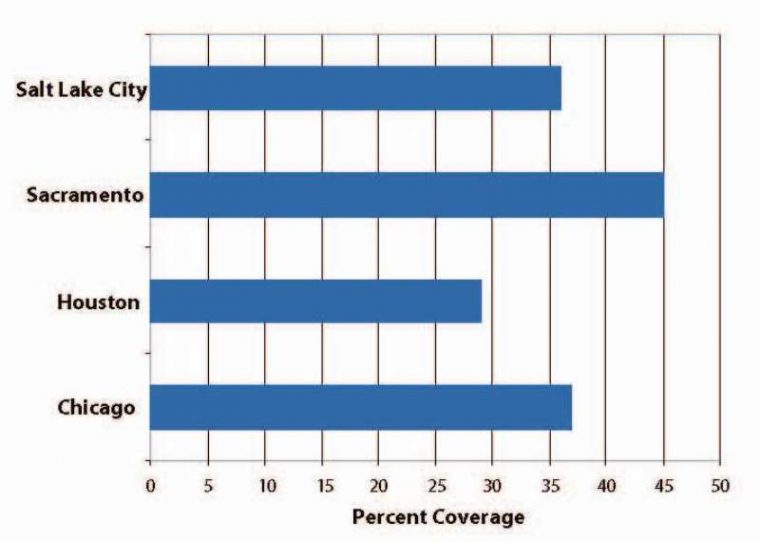Cool pavement technology could greatly reduce global cooling and contribute to human health and comfort, especially as climate change continues to escalate. UCLA scientists predict that the number of hot days over 95 degrees will triple or quadruple by 2050. This predicted heat increase will be especially strong in metropolitan areas.
Scientists have been actively researching for ways to reduce the urban heat island effect. An urban heat island (UHI) is simply an urban area that is significantly warmer than surrounding, (often) more rural areas due to human activity and the resulting carbon footprint. These “islands” of heat also occur partly due to dark, dry surfaces like buildings and roads in cities, which add to the heightened temperatures in these areas. The EPA claims that pavement makes up 30-45% of land cover in cities. Considering that traditional asphalt absorbs 80-95% of sunlight, targeting pavement technology appears to be one of the top ways to curb city heat.

Asphalt Coverage Comparison for Some Key Metropolitan Areas
Photo: Pavement Interactive
Cool pavements can reflect up to 50% of sunlight. They come in a few different forms. One type of cool pavement uses conventional concrete. Another type uses a clear binder that contains a highly-reflective aggregate. Yet another type uses a cool-colored coating on traditional asphalt. Canoga Park in LA recently applied a cool pavement surface coating to Jordan Avenue. When they compared the cool pavement temperature with a nearby asphalt road, the cool pavement read 70 degrees while the asphalt read 93 degrees.
Despite the “pros” of global cooling and increased human comfort, this innovative technology does have some apparent “cons.” New research from the Department of Energy’s Lawrence Berkeley National Laboratory (Berkeley Lab) suggests that the energy output for making cool pavements is greater than the energy savings that this technology yields. As one of the lead researchers, Ronnen Levinson, testifies: “Maintaining a reflective coating would require over six times as much energy as a slurry seal. The slurry seal is only rock and asphalt, which requires little energy to produce, while the reflective coating contains energy-intensive polymer.”
Sun Protection Smarts: Check out the Kia Cadenza’s rear sunshades
Sharon Chen and Ana Paula Werle of the Berkeley Lab Heat Island Group engaging with a test patch of cool pavement.
Photo: Roy Kaltschmidt/Berkeley Lab
The research also indicated that it’s more expensive to make than traditional asphalt. Melvin Pomerantz, another core researcher of the Berkeley Lab’s Heat Island group, analyzed electricity use data for seven urban heat islands in CA. He then calculated the maximum possible electricity saved and avoided CO2 emissions from using cool pavements. According to the results, the annual decrease in electricity usage was less than 1 kWh per square meter of cool pavement. The overall energy conservation savings totaled less than 60 cents per year; the avoided CO2 was under 1 cent per year.
Looking for an Eco-Friendly Hybrid? Check out the 2017 Kia Niro
Currently, scientists are torn on cool pavement technology. Are the perks greater than the cons? Ronnen Levinson admits, “The one-time global cooling benefit of cool pavements is substantially larger than the 50-year life cycle carbon penalty or savings.” The goal is to tweak the cool pavement technology so it’s cheaper and has less of a carbon footprint. For the sake of global cooling and general human comfort in spite of the predicted heat wave, we’re excited about this new technology as scientists continue to perfect it.
Sources: Phys.org, EPA, LA Times, Heat Island Group, Los Angeles Daily News, Pavement Interactive
Whitney Russell resides in Dayton, though her spirit can be found beach-bumming in Puerto Rico (the land of her half-Puerto Rican heritage). When not crafting car-related content, she can be found chasing after the most amazing toddler in the world, watching her “beaver” of a husband build amazing woodworking projects, hanging out with two crazy dogs, and visiting family and friends. She also enjoys traveling, crafting, and binge-watching period dramas when time allows. See more articles by Whitney.